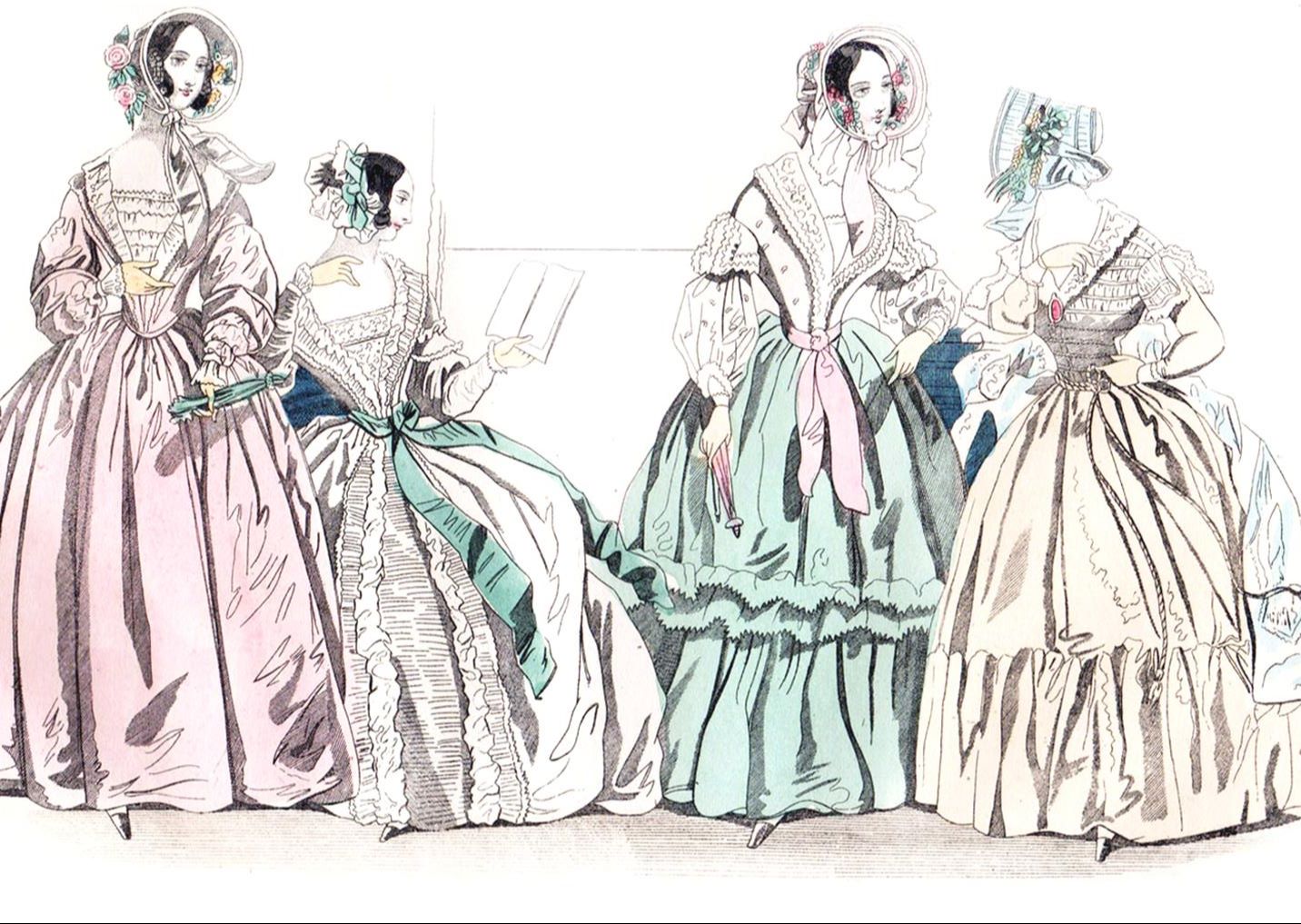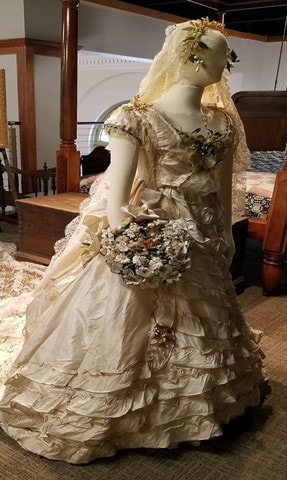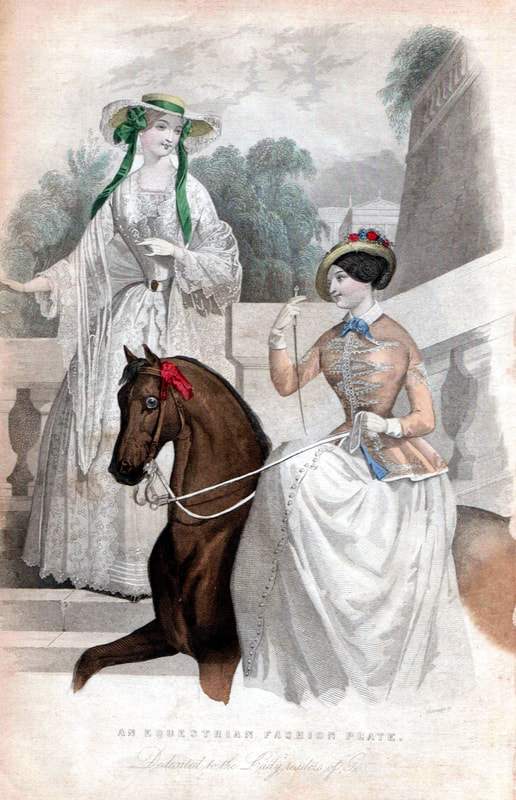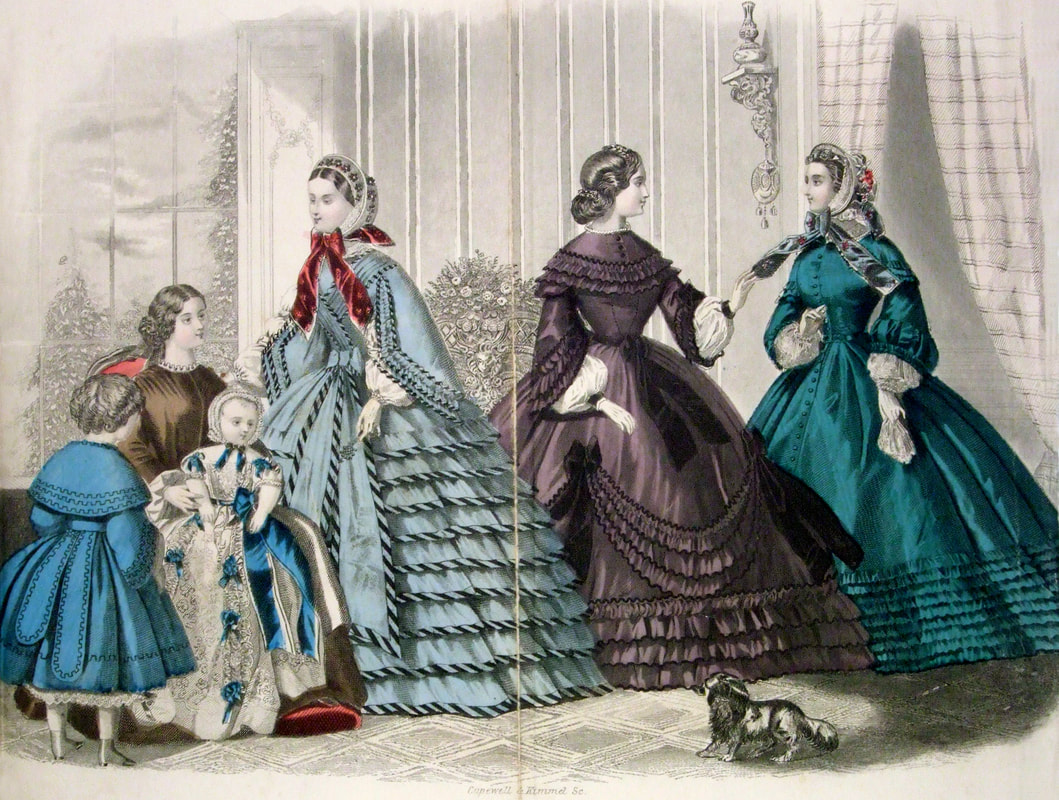|
Good morning everyone! I love cased images. They offer so much detail that every time you look at them you see something new.
The above image is a 1/6 plate ambrotype probably dating between 1856 and 1858. How do I know? The bonnets. Bonnets between 1856 and 1858 were extremely small, sat very low and back on the head. From the front, they look like little halos. In this image, the ties are wide and long. Even when tied, the ends reach to the elbows of the wearers. Some bonnets in the 1850s show shorter ties, but as we move towards the 1860s ties are long. The most important detail to note about the bonnet trimming is the very full cap of netting. If there is any detail reproductions miss, the amount of netting on late 1850s and early 1860s bonnets. If you are trimming a bonnet and wonder if you need more netting, the answer is yes. I am off for now, but stay tuned for your next installment of Wet Plate Wednesday!
0 Comments
Recently while scrolling through images on eBay, I spotted this image of mother and child. It was labeled "Antique Tintype Daguerreotype Photograph of Mother & Child In Original Frame". I scratched my head a bit. Which is it? A tintype or daguerreotype? From her clothing, I suspected she was a tintype or an ambrotype. I prefer cased images to CDVs because of the level of detail. The price was affordable for a tintype and out of this world for a daguerreotype, so I bit. When she arrived in the mail, I was eager to find the answer to the mystery (I think I am easily amused or excited in the covid 19 era). She was, as I suspected, an ambrotype. The clarity and detail of the mother were very good and the blurry baby with a hint of smile around the eyes reminded me of photographs of my own children.
Unfortunately, many people do not know the differences between these types of early photography even at museums. Our local history museum was very suspicious of me when I said they had a tintype mislabeled as a daguerreotype. "How do you know? We have been told by an expert that this is a daguerreotype?" I guess the best place to start getting people to know the correct information is sharing it. I am not a photography expert, just a collector of images, but here are some definitions to help identify types of cased images. Daguerreotype - Positive image on silver. Introduced by Jacques Daguerre in 1839. Expensive and labor intensive, but very high quality images. Quickly replaced by the Ambrotype and Ferrotype in the 1850s. Although the images are durable, tarnish to the silver plate can cause irreparable damage the image. Ambrotype - Negative image on glass with black backing. Patented in the United States in 1854. Much cheaper process than the Daguerreotype. Unfortunately, the images are vulnerable in comparison to daguerreotypes and ferrotypes. Ferrotype - Popularly referred to as tintypes. Negative image on iron coated with lacquer or black paint. Invented in Ohio by Hamilton Smith in 1856. Much less expensive and more durable than Ambrotype. Ferrotypes did not require a case. In the US, the ferrotype replaced the ambrotype by the end of the American Civil War. Popularity of the ferrotype did not catch on as quickly in Europe.  Godey’s Lady’s Book April 1841 Description of Fashion Plate Fig. 1. – Dress of poux de soie ; blue shot with pink. The corsage is plain at back and half high ; the fronts also tight to the shape, but only meeting at the very waist, being sloped away in the form of a V, and trimmed with two rows of falling lace. The skirt is without garniture, save a hem of itself about a quarter of a yard in depth ; the sleeves are plain and loose, cut out on the straight way of the material ; they are not confined any where, and reach only midway of the lower arm, the buttons of the sleeves being turned up like cuffs, (see plate), in order to display a pair of under sleeves, made of fine India muslin ; these sleeves belong to a corsage, the front of which is to be seen ; it has drawings across like the sleeves, and is finished at top by a row of narrow lace edging ; deep ruffles of lace fall over the hands. The hat is of white crepe lisse and has three flowers at the side ; the strings are of crape lisse, with a very fine satin piping all round, and edged with narrow blonde. It will be perceived, that the crown of the bonnet sits so flat that it is not at all perceptible in front. Flowers underneath the bonnet. Fig. 2. – Dress of white book muslin. The corsage is precisely the same as the one just described, except, that instead of being trimmed with two falls of lace, it has two frills of muslin small plaited, and put on with a bouillon, through which a ribbon may be inserted at pleasure. This trimming is continued down the front of the skirt of the dress, the bouillon small plaited, and inserted down the centre of the front ; a glance at out plate will suffice to make this intelligible. The chemisette, appearing in fornt, is richly embroidered. The sleeves of this dress are plain at the shoulder, and the remainder nearly tight. Gauze cap trimmed with satin ribbon ; the cap is without strings to tie. Hiar in bands, brought low at the sides of the face, where it is turned up again. Fig. 3. – The corsage almost similar to that of figure 1, differing in having a ribbon run through it, (see plate). Bishop sleeves, pointed cuffs, with a cap at the top of the sleeve trimmed to correspond with the collar. Rosette and ends at the waist, coloured silk skirt, a wide flounce and heading pinked out. Bonnet of fancy lace, trimmed with lace and flowers. Fig. 4. – Dress of silk or muslin, with tight sleeves, lace waist, made of puffs and with caps on the sleeves to put on over the dress ; the waist finished with cord and tassel ; one extra wide flounce. Drawn bonnet, cottage form, trimmed with wheat and ribbon. Light fancy sash. Godey’s Lady’s Book
January, 1849 Description of the Fashion Plate. Having “distanced” all our contemporaries, it only remained for us to anticipate Nature, and we therefore present a picture of green fields and waving woodlands, even though January’s cold may be at this moment chilling the graceful forms of our lady readers. Seriously, having given all the stylish cloaks and mantillas that pleased us, and thinking by this time they had been profited by in the selection of winter wardrobes, we have exerted our taste and ingenuity in getting out a pretty spring costume, that our demoiselles may have some clue to what will be worn the ensuing season. Apart from the information conveyed, we flatter ourselves that as a picture, it adds much to the beauty of the number, and will bear preservation long after the styles it faithfully portrays shall have become antique. Figure 1st – Riding dress for the country. – Leghorn hat, with a rolled brim, the dress a full skirt of pale drab-colored cashmere, fastened up the front by a close row of very small silk buttons of the same color. A “Jack Sheppard” waist (see Lady’s Book for November) of nankeen, with a rich white linen braid embroidery on the front and sleeves. The short skirt, or basque, is trimmed in the same way as the waist, and lined with pale blue Florence silk. Plain linen collar and cuffs, and a blue ribbon neck tie. Gloves as near as possible the shade of the waist. 2d figure – Morning dress for a watering-place. – Under robe of white cambric muslin, with a border of narrow tucks and fine embroidery. Over dress of jaconet muslin, the sleeves wide and loose at the wrist. This robe has a rich border of needlework, with a scalloped edge. A belt of pale green fastened by a small gold buckle, confines it at the waist. Hat of uncut Leghorn, trimmed with pale green ribbon, and a fall of deep lace, that, thrown back over the brim, serves as a veil. The hat is designed expressly and only for the country, where it will be found very useful. Godey’s Lady’s Book
April 1861 Description of Steel Fashion-Plate for April. Fig. 1.—Child’s walking-dress of blue cashmere, with small round pelerine. The dress is braided with very narrow black velvet, and has long ends of the cashmere, braided, fastened to a belt falling at the back. Fig. 2.—Infant’s robe, elegantly embroidered en tablier; trimmed with blue rosettes; wide sash of blue ribbon, and cap trimmed to match. Fig. 3.—Nurses’ dress of brown de laine, with narrow frill at the neck. Fig. 4.—Dress of lavender-colored silk, with nine graduated flounces bound with lavender silk, relieved with black velvet stripes; sash bound with the same; body plain, trimmed with folds of the material, crossing from right to left in front; angel sleeves, trimmed with a puffing of the silk, and caught together with narrow bands. Straw-colored gloves, with two buttons, and worked with lavender-color. Bonnet of rice straw, trimmed with fuchsia-colored ribbon and Marguerites of the same color. Fig. 5.—A wine-colored silk, with three flounces bound with black velvet and a puffing at the bottom of the skirt; then three flounces graduated in their width, and a puffing put on in festoons, each festoon being caught up with a large ribbon bow and ends; body trimmed en berthé, with two ruffles and a puffing; sleeves loose, and trimmed to match the skirt. Ribbon sash, with bow and ends. Gloves worked with wine-color, to match the dress. Frill of lace round the neck. Fig. 6.—Green silk dress, having the front breadth gored, and nine very small ruffles at the bottom of the skirt; a row of buttons down the front of the dress; body plain; sleeves with caps, and trimmed at the bottom with box plaits and ruching. Point lace collar and sleeves. Leghorn bonnet, trimmed with bunches of cherries; the bonnet ribbon has also cherries worked on it. Gloves worked with green. |
AuthorUsually Dannielle, sometimes Mandy Archives
January 2021
Categories |




 RSS Feed
RSS Feed